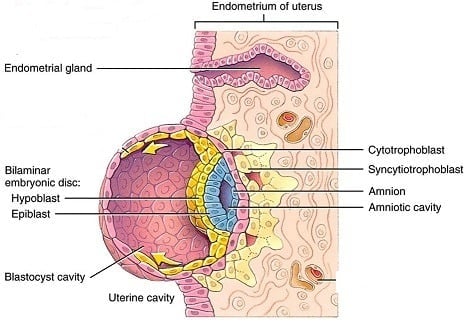- As implantation of the blastocyst occurs, morphologic changes in the embryoblast produce a bilaminar embryonic disc composed of epiblast and hypoblast cells.
- Epiblast is derived from the inner cell mass and lies above the hypoblast.
- The epiblast is thus, one of the two distinct layers arising from the inner cell mass in the mammalian blastocyst.
- It can first be identified as tissue at the late blastocyst stage and formed by the second week of development.
- The epiblast, whilst referred to as the primary ectoderm, differentiates to form all three layers of the trilaminar germ disc in a process called gastrulation.
- It gives rise to the three primary germ layers (ectoderm, definitive endoderm, and mesoderm) and to the extraembryonic mesoderm of the visceral yolk sac, the allantois, and the amnion.
- During gastrulation, the epiblast cells undergo epithelial-to-mesenchymal transition and delaminate to become the loose mesenchyme of the primitive streak.
- Its pluripotency is its most distinctive property.

Image Source: Simplified Biology
Interesting Science Videos
Development of Epiblast
- In mammalian embryogenesis, differentiation and segregation of cells composing the inner cell mass of the blastocyst yields two distinct layers—the epiblast (“primitive ectoderm”) and the hypoblast (“primitive endoderm”).
- While the cuboidal hypoblast cells delaminate ventrally, away from the embryonic pole, to line the blastocoele, the remaining cells of the inner cell mass, situated between the hypoblast and the polar trophoblast, become the epiblast and comprise columnar cells.
Epiblast vs Hypoblast
| Characteristic | Epiblast | Hypoblast |
| Definition | One of the two layers of the embryonic disc that forms three primary germ layers and amniotic ectoderm. | The second layer of the embryonic disc that forms the yolk sac. |
| Also called as | Primitive ectoderm | Primitive endoderm |
| Layer | Outer Layer | Inner Layer |
| Develops into | Embryo proper | Yolk sac |
| Cell shape | Columnar cells | Cuboidal cells |
| Location | Lies above the hypoblast | Lies below the epiblast |
| Contribution to Embryo | Yes | No |
Significance of Epiblast Cells
- Primordial germ cells are specified from epiblast cells.
- The migration, invagination, and differentiation of the epiblast are important for embryonic cellular rearrangements.
- The epiblast is known to generate all fetal cell lineages, including the germline.
References
- Gilbert, S. F. (2000). Developmental biology. Sunderland, Mass: Sinauer Associates.
- Schoenwolf, G.C., Bleyl, S.B., Brauer, P.R., Francis-West, P.H. & Philippa H. (2015). Larsen’s human embryology (5th ed.). New York; Edinburgh: Churchill Livingstone.
- Sadler, T. W., & Langman, J. (2004). Langman’s medical embryology. Philadelphia, Pa: Lippincott Williams & Wilkins.
- Moore, K. L., Persaud, T. V. N., & Torchia, M. G. (2008). The developing human: Clinically oriented embryology. Philadelphia, PA: Saunders/Elsevier.
- https://discovery.lifemapsc.com/in-vivo-development/epiblast/epiblast
- https://www.sciencedirect.com/topics/medicine-and-dentistry/epiblast
- https://dev.biologists.org/content/130/15/3491
- http://www.columbia.edu/itc/hs/medical/humandev/2006/HD1/Cleavage.pdf
- Epiblasthttps://www.differencebetween.com/difference-between-epiblast-and-hypoblast/
